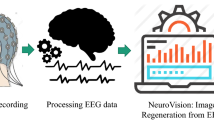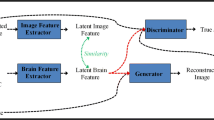Abstract
Generative Adversarial Networks have recently proven to be very effective in generative applications involving images, and they are now being used to regenerate images using visually evoked brain signals. Recent neuroscience research has discovered evidence that brain-evoked data can be used to decipher how the human brain functions. Simultaneously, the latest advancement in deep learning integrated with a high-level interest in generative methods has made learning the data distribution possible and realistic images can be produced from random noise. In this work, an advanced generative adversarial method that incorporates the capsule network with the generative adversarial networks model i.e. Capsule Generative Adversarial Network is proposed to regenerate images with decoded information and formulated features from visually evoked brain signals. There are two stages in the proposed method: Encoder, for data formulation of visually evoked brain activity and the image reconstruction phase from the brain signals. The image regeneration technique has been experimentally tested on a variety of generative adversarial networks including the proposed model and the final reconstructed image samples are compared to assess the quality using various evaluation metrics. The Structural Similarity Index Measure metric for Capsule Generative Adversarial Network has achieved highest value i.e., 0.9203 and outperforms the other GAN variants and also indicates that the Capsule Generative Adversarial Network reconstructed the images similar to original images.





Similar content being viewed by others
Data Availability
The datasets analyzed during the current study are available in the MNIST database (Modified National Institute of Standards and Technology database, http://yann.lecun.com/exdb/mnist/) and MindBigData (the “MNIST” of Brain Digits, http://www.mindbigdata.com/opendb/index.html) repository.
References
Acharya UR, Sree SV, Swapna G, Martis RJ, Suri JS (2013) Automated EEG analysis of epilepsy: a review. Knowl-Based Syst 45:147–165
Anwar S, Meghana S (2019) A pixel permutation based image encryption technique using chaotic map. Multimed Tools Applic 78(19):27569–27590
Anwar S, Rajamohan G (2020) Improved image enhancement algorithms based on the switching median filtering technique. Arab J Sci Eng 45 (12):11103–11114
Berthelot D, Schumm T, Metz L (2017) BEGAN: boundary equilibrium generative adversarial networks. arXiv:1703.10717
Bhat S, Hortal E (2021) Gan-based data augmentation for improving the classification of eeg signals. In: The 14th pervasive technologies related to assistive environments conference, pp 453–458
Bird JJ, Faria DR, Manso LJ, Ekárt A, Buckingham CD (2019) A deep evolutionary approach to bioinspired classifier optimisation for brain-machine interaction. Complexity, 2019
Carlson T, Tovar DA, Alink A, Kriegeskorte N (2013) Representational dynamics of object vision: the first 1000 ms. J Vis 13(10):1–1
de Beeck HPO, Torfs K, Wagemans J (2008) Perceived shape similarity among unfamiliar objects and the organization of the human object vision pathway. J Neurosci 28(40):10111–10123
Donahue J, Krähenbühl P, Darrell T (2016) Adversarial feature learning. arXiv:1605.09782
Goodfellow I, Pouget-Abadie J, Mirza M, Xu B, Warde-Farley D, Ozair S, Courville A, Bengio Y (2014) Generative adversarial nets. In: Advances in neural information processing systems (NIPS)
Goodfellow I, Pouget-Abadie J, Mirza M, Xu B, Warde-Farley D, Ozair S, Courville A, Bengio Y (2014) Generative adversarial nets. In: Ghahramani Z, Welling M, Cortes C, Lawrence N, Weinberger K Q (eds) Advances in neural information processing systems, vol 27. Curran Associates, Inc.
Gulrajani I, Ahmed F, Arjovsky M, Dumoulin V, Courville A (2017) Improved training of wasserstein GANS. arXiv:1704.00028
Guo K, Hu X, Li X (2022) Mmfgan: a novel multimodal brain medical image fusion based on the improvement of generative adversarial network. Multimed Tools Applic 81(4):5889–5927
Gupta A, Venkatesh S, Chopra S, Ledig C (2019) Generative image translation for data augmentation of bone lesion pathology. In: International conference on medical imaging with deep learning, PMLR, pp 225–235
Ha K-W, Jeong J-W (2019) Motor imagery eeg classification using capsule networks. Sensors 19(13):2854
Hartmann KG, Schirrmeister RT, Ball T (2018) Eeg-gan: generative adversarial networks for electroencephalograhic (EEG) brain signals. arXiv:1806.01875
Hassan MA, Khan MUG, Iqbal R, Riaz O, Bashir AK, Tariq U (2021) Predicting humans future motion trajectories in video streams using generative adversarial network. Multimedia Tools and Applications, 1–23
Hinton GE, Krizhevsky A, Wang SD (2011) Transforming auto-encoders. In: International conference on artificial neural networks. Springer, pp 44–51
Huth AG, Lee T, Nishimoto S, Bilenko NY, Vu AT, Gallant JL (2016) Decoding the semantic content of natural movies from human brain activity. Front Syst Neurosci 10:81
Hwang S, Hong K, Son G, Byun H (2019) EZSL-GAN: EEG-based zero-shot learning approach using a generative adversarial network. In: 2019 7th International winter conference on Brain-Computer Interface (BCI). IEEE, pp 1–4
Im DJ, Kim CD, Jiang H, Memisevic R (2016) Generating images with recurrent adversarial networks. arXiv:1602.05110
Jaiswal A, AbdAlmageed W, Wu Y, Natarajan P (2018) Bidirectional conditional generative adversarial networks. In: Asian conference on computer vision. Springer, pp 216–232
Jaiswal A, AbdAlmageed W, Wu Y, Natarajan P (2018) CapsuleGAN: generative adversarial capsule network. In: Proceedings of the european conference on computer vision (ECCV) workshops
Kavasidis I, Palazzo S, Spampinato C, Giordano D, Shah M (2017) Brain2image: converting brain signals into images. In: Proceedings of the 25th ACM international conference on multimedia, pp 1809–1817
Khare S, Choubey RN, Amar L, Udutalapalli V (2022) Neurovision: perceived image regeneration using cprogan. Neural Comput Appl 34 (8):5979–5991
Kim T, Cha M, Kim H, Lee JK, Kim J (2017) Learning to discover cross-domain relations with generative adversarial networks. In: International conference on machine learning, PMLR, pp 1857–1865
Lanaras C, Bioucas-Dias J, Galliani S, Baltsavias E, Schindler K (2018) Super-resolution of sentinel-2 images: learning a globally applicable deep neural network. ISPRS J Photogramm Remote Sens 146:305–319
LeCun Y, Bottou L, Bengio Y, Haffner P (1998) Gradient-based learning applied to document recognition. Proc IEEE 86(11):2278–324
Lee H-Y, Tseng H-Y, Huang J-B, Singh M, Yang M-H (2018) Diverse image-to-image translation via disentangled representations. In: Proceedings of the european conference on computer vision (ECCV), pp 35–51
Luo Z (2019) Face rotation via VAE-capsuleGAN. In: IOP Conference series: earth and environmental science, vol 252. IOP Publishing, p 042127
Majdabadi MM, Ko S-B (2020) Msg-capsgan: Multi-scale gradient capsule GAN for face super resolution. In: 2020 International Conference on Electronics, Information, and Communication (ICEIC). IEEE, pp 1–3
Marusaki K, Watanabe H (2020) Capsule GAN using capsule network for generator architecture. arXiv:2003.08047
Mirza M, Osindero S (2014) Conditional generative adversarial nets. arXiv:1411.1784
Odena A, Olah C, Shlens J (2017) Conditional image synthesis with auxiliary classifier GANS. In: International conference on machine learning, PMLR, pp 2642–2651
Olivas-Padilla BE, Chacon-Murguia MI (2019) Classification of multiple motor imagery using deep convolutional neural networks and spatial filters. Appl Soft Comput 75:461–472
Palazzo S, Spampinato C, Kavasidis I, Giordano D, Shah M (2017) Generative adversarial networks conditioned by brain signals. In: Proceedings of the IEEE International conference on computer vision, pp 3410–3418
Radford A, Metz L, Chintala S (2015) Unsupervised representation learning with deep convolutional generative adversarial networks. arXiv:1511.06434
Ramos-Aguilar R, Olvera-López JA, Olmos-Pineda I, Sánchez-Urrieta S (2020) Feature extraction from EEG spectrograms for epileptic seizure detection. Pattern Recogn Lett 133:202–209
Sabour S, Frosst N, Hinton GE (2017) Dynamic routing between capsules. arXiv:1710.09829
Sara U, Akter M, Uddin MS (2019) Image quality assessment through fsim, ssim, mse and psnr—a comparative study. J Comput Commun 7(3):8–18
Seeliger K, Güçlü U, Ambrogioni L, Güçlütürk Y, van Gerven MAJ (2018) Generative adversarial networks for reconstructing natural images from brain activity. Neuroimage 181:775–785
Shao G, Huang M, Gao F, Liu T, Li L (2020) Ducagan: unified dual capsule generative adversarial network for unsupervised image-to-image translation. IEEE Access 8:154691–154707
Song J, Guo Y, Gao L, Li X, Hanjalic A, Shen HT (2018) From deterministic to generative: multimodal stochastic RNNs for video captioning. IEEE Trans Neural Netw Learn Syst 30(10):3047–3058
Song J, Zhang J, Gao L, Liu X, Shen HT (2018) Dual conditional GANs for face aging and rejuvenation. In: IJCAI, pp 899–905
Tirupattur P, Rawat YS, Spampinato C, Shah M (2018) Thoughtviz: visualizing human thoughts using generative adversarial network. In: Proceedings of the 26th ACM international conference on multimedia, pp 950–958
Upadhyay Y, Schrater P (2018) Generative adversarial network architectures for image synthesis using capsule networks. arXiv:1806.03796
Wang Z, Bovik AC (2002) A universal image quality index. IEEE Signal Process Lett 9(3):81–84
Wang R, Li G, Chu D (2019) Capsules encoder and CapsGAN for image inpainting. In: 2019 International conference on artificial intelligence and advanced manufacturing (AIAM). IEEE, pp 325–328
Yuhas RH, Goetz Alexander FH, Boardman JW (1992) Discrimination among semi-arid landscape endmembers using the spectral angle mapper (SAM) algorithm. In: Proc. summaries 3rd Annu. JPL airborne geosci. Workshop, vol 1, pp 147–149
Zhang L, Zhang L, Mou X, Zhang D (2011) Fsim: a feature similarity index for image quality assessment. IEEE Trans Image Process 20(8):2378–2386
Zhang X, Chen X, Dong M, Liu H, Ge C, Yao L (2019) Multi-task generative adversarial learning on geometrical shape reconstruction from EEG brain signals. arXiv:1907.13351
Zhu J-Y, Park T, Isola P, Efros AA (2017) Unpaired image-to-image translation using cycle-consistent adversarial networks. In: Proceedings of the IEEE international conference on computer vision, pp 2223–2232
Funding
No funding was received to assist with the preparation of this manuscript.
Author information
Authors and Affiliations
Corresponding author
Ethics declarations
Competing interests
The authors have no competing interests to declare that are relevant to the content of this article.
Additional information
Publisher’s note
Springer Nature remains neutral with regard to jurisdictional claims in published maps and institutional affiliations.
Rights and permissions
Springer Nature or its licensor (e.g. a society or other partner) holds exclusive rights to this article under a publishing agreement with the author(s) or other rightsholder(s); author self-archiving of the accepted manuscript version of this article is solely governed by the terms of such publishing agreement and applicable law.
About this article
Cite this article
Kumari, N., Anwar, S., Bhattacharjee, V. et al. Visually evoked brain signals guided image regeneration using GAN variants. Multimed Tools Appl 82, 32259–32279 (2023). https://doi.org/10.1007/s11042-023-14769-4
Received:
Revised:
Accepted:
Published:
Issue Date:
DOI: https://doi.org/10.1007/s11042-023-14769-4




